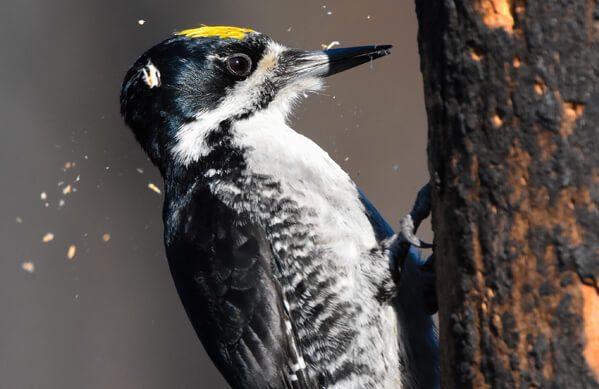
Black-backed Woodpecker range map by American Bird Conservancy
A burned-over forest may look lifeless and dreary to the human eye, but to the Black-backed Woodpecker, it's a veritable welcome mat. This glossy-backed bird blends in beautifully with the charred trees it prefers; in fact, it's far less likely to be seen away from a burned area than in one. This species is one of the first to recolonize a forest after a major fire, along with other species such as the White-headed and Hairy Woodpeckers.
Excavation Adaptations
The Black-backed Woodpecker's seemingly odd choice of habitat makes a lot of sense when you think about the bird's diet. A post-fire forest of charred conifers attracts wood-boring beetles and their larvae, as well as other insects, providing a ready woodpecker buffet. These dead trees (also known as snags) are also perfect places to excavate cavities for nesting and roosting.
In an interesting adaptation for more efficient excavating, this species, along with the American Three-toed Woodpecker, only has three toes per foot — two facing forward and one back. This arrangement differs from the typical woodpecker foot arrangement of two toes forward and two back, as seen in the Red-bellied and Lewis's Woodpeckers. The absence of a back toe allows this bird to pivot farther back while preparing to hammer at a tree trunk, making the ensuing blows more forceful.
Burnout Buffet
The Black-backed Woodpecker feeds primarily on the wood-boring insects and larvae that infest burnt trees in the wake of fires. A modified skull and rib cage help it withstand the pounding required to excavate deep into wood after its prey. In fact, researchers found that this species has the most shock-absorbent skull in the genus Picoides.
With its sturdy, chisel-like bill, the Black-backed Woodpecker scales off large pieces of bark from charred tree trunks. Patches of exposed orange cambium (inner bark) that stand out against blackened trunks are a sure sign a Black-backed Woodpecker has been at work.
In addition to beetles, grubs, and other insects, this woodpecker sometimes eats berries, acorns, and nuts, but these items make up just a small part of its diet.
Scream, Rattle, and Snarl
Despite having a wide range across northern North America and in the northern Rockies and Sierra Nevada, the Black-backed Woodpecker has no recognized subspecies. Populations are nonmigratory but shift as previously burned forests re-grow and new areas burn. These birds also take advantage of forests denuded by bark beetle outbreaks, but to a lesser extent.
The Black-backed Woodpecker's call note, a sharp kyik, is most commonly heard as it forages and interacts.
(Audio: Black-backed Woodpecker call by Frank Lambert, XC408789. Accessible at www.xeno-canto.org/408789.)
This woodpecker has another interesting call known as the “scream-rattle-snarl,” one of the most complex vocalizations in its genus. This call is most often heard as a bird establishes or defends territory.
(Audio: Black-backed Woodpecker call by Geoffrey A. Keller, ML50124. Accessible at www.macaulaylibrary.org/asset/50124.)
Primary Pair-ups
Black-backed Woodpeckers stay paired throughout the year. Similar to other woodpeckers, from Downy to Pileated, this species is a primary cavity nester, meaning that it excavates its own nest site. Male and female share the work of chiseling out the nest cavity in a dead or dying tree, then incubating their two to six white eggs, and feeding the nestlings once they hatch. The vociferous young leave the nest after about a month, and learn to forage on their own by imitating their parents.
Researchers have found that Black-backed Woodpeckers play a key role in providing cavities that help other animals repopulate burned forests. These secondary cavity users, including birds such as the Mountain Bluebird and White-breasted Nuthatch, and small mammals such as flying squirrels, help disperse seeds, keep insect populations in check, and serve as prey for larger carnivores during post-fire forest regeneration.

Female Black-backed Woodpecker by Lev Frid/Shutterstock
Conservation by Fire
Fire suppression and salvage logging pose particular threats to the Black-backed Woodpecker, as both result in what is essentially habitat loss for this and other species. Fire management is a very important topic, especially in the West, where there has been an increase in catastrophic blazes, including the Camp Fire in California in 2018. ABC is working with partners to recommend best management practices for birds on private lands managed to prevent fire in the Sierra foothills of California.
The issue of fire, forestry, and birds is complex, but ABC is committed to working with partners and local communities to ensure human safety while safeguarding fire-dependent species such as the Black-backed Woodpecker.
Private landowners can help cavity-nesting birds by retaining snags. For those living in Ponderosa Pine country, we have several publications with recommendations for managing habitat here and here.
Donate to support ABC's conservation mission!



















































